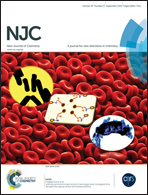Efficiency enhanced rutile TiO2 nanowire solar cells based on an Sb2S3 absorber and a CuI hole conductor†
Abstract
Despite the excellent photo-generated charge separation and transport properties of the 1D rutile TiO2 nanowire (NW) array, insufficient light harvesting due to a low surface area is a key factor that limits the photovoltaic performance of TiO2 NW-based solar cells. Herein, we apply the Sb2S3 semiconductor as a light absorber and sprayed p-CuI as a hole conductor for TiO2 NW solar cells. The Sb2S3-sensitized device displays significantly improved light absorption compared to its corresponding dye-sensitized device, with a peak incident-photon-to-current conversion efficiency (IPCE) of 64%. Moreover, CuI film deposited by the spray technique enables improved pore filling and better electrical contact between the Sb2S3 absorber and CuI, as well as CuI crystals themselves, and facilitates hole transfer from Sb2S3 to CuI crystals and hole transportation in the CuI layer. As a result, the TiO2 NW/Sb2S3/CuI-spray/Au device exhibits an overall power conversion efficiency of 1.18% under AM 1.5G simulated solar irradiation, which is about 2.88 times and 2.11 times higher than TiO2 NW/N719/CuI-spray/Au and TiO2 NW/Sb2S3/CuI-drop coating/Au devices, respectively. This study thus demonstrates the superiority of the Sb2S3 sensitizer for TiO2 NW solar cells and the spray technique for the preparation of the p-CuI hole conductor.


 Please wait while we load your content...
Please wait while we load your content...